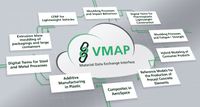Addressing the Challenge – Integrated Virtual Engineering Workflows
The lack of software standards in virtual engineering workflows and incompatible interfaces for the transfer of virtual data not only cause additional costs and complex manual adaptation but also lead to inflexible IT solutions, loss of information and significant delays in the overall design process. The standardisation of data interfaces in CAE is therefore vital for all industry segments where simulation processes are central to the product and process design.
Various industry partners already have adopted their own CAE-workflows to the VMAP standard and could gain significant benefits in saving time and implementation efforts. The initial ITEA VMAP project highlights some typical engineering cases from different material and manufacturing domains. The VMAP Standard is a software interface that was developed by 29 contracting parties coming from 6 countries.
ITEA is a R&D program to foster software innovation and standardization at the European level. The goal of this program is, among other things, to turn innovative ideas into new businesses, jobs, economic growth and to benefit society.
The VMAP Standards Community
In December 2022 sixteen founding members – partially coming from the initial ITEA project – established the VMAP Standards Community (VMAP SC) to be registered as a not-for-profit association. VMAP SC will be open to all, who intend to contribute to the VMAP Standard and its extension, thereof.
The VMAP SC makes the software parts of the standard available to the general public as open source software free of charge. Especially, companies in the manufacturing industry, software companies and research institutes can profit from the use of the software.
Through the technical maintenance of the standard and the supervision of its further development, the VMAP association will offer the possibility to make the developed standard accessible to a broad interested public, to explain its application and to further develop the technology according to the requirements of the users. This will make the standard accessible to a wide audience and the VMAP SC will thus ensure equal opportunities for all potential users.
